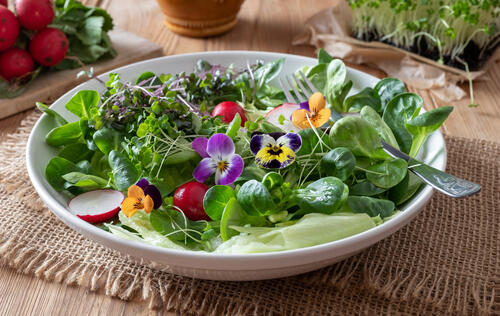Grow ginger and garlic on your balcony

Growing ginger
Renowned for its exceptional medicinal and culinary properties, ginger is a rather expensive commodity. Growing ginger is fairly simple, and can be done in a container on a balcony or terrace.
All you have to do is buy a plump ginger rhizome at a market or health food store. Then plant the rhizome in a large container, 35 to 40 cm in diameter, filled with compost-rich potting soil. Be sure to arrange the rhizome on the surface of the potting soil, so that the top of the rhizome protrudes slightly from the soil.
inger is best planted in spring or early summer, but can also be planted at other times of the year. However, it’s important not to leave your ginger outside during the cold season. Once autumn arrives, it’s imperative to bring your ginger plant into the house and place it in a bright spot. Harvesting can take place five to six months later.
Ginger is a tropical plant that loves heat (22 to 25°C) and constant humidity. To prevent rotting, however, avoid over-watering before the plant has taken root. During this period, watering should only be carried out when the surface of the potting soil is dry. More water can be applied once the stems are well developed, i.e. once or twice a week.
Potted garlic
Garlic has long been appreciated by humans for its exceptional culinary and therapeutic virtues. In China and the Middle East, use of the plant dates back as far as 3000 BC. The Egyptians were quite taken with the plant and, it seems, provided a daily ration to the laborers building the pyramids.
Garlic is generally planted in autumn, from mid-September to mid-October, around three to six weeks before the ground freezes. Most varieties of garlic can easily be grown right in the heart of the city, on a balcony or terrace. In this case, you’ll need to plant garlic in a pot or tub, in a rich, well-drained soil composed of compost, sphagnum peat moss and perlite. You’ll also need to place the container in which you grow your garlic in a location where it will receive a minimum of six hours of sunlight. Opt for a hard-stemmed garlic cultivar that is robust and resistant to harsh winters, such as the ‘Music’ variety.
When grown out of the ground, the challenge is to ensure that garlic survives the winter. It is therefore highly recommended to grow this plant in a textile container specially designed for urban agriculture. This type of pot, made of thick geotextile, provides better insulation during the winter and ensures excellent drainage of the potting soil, encouraging it to crystallize rather than form a block of ice.
To increase the chances of survival of potted garlic, rather than leaving it on the terrace or balcony, it can be moved and placed directly on the ground towards the end of autumn. You can cover the pot with dead leaves to protect it better in cold weather when there’s no snow. You can also cover the container with snow as soon as the first flush of snow falls.
Each clove planted will produce a bulb. Plant each bulb separately, pointing upwards and covering with 4 or 5 cm of potting soil. Leave around 10 to 15 cm between cloves. Then cover the soil with a 2 cm layer of compost. As well as preventing soil erosion, the compost will protect the cloves over winter and provide nutrients in spring.
When rain is scarce, don’t hesitate to water so that the garlic bulbs reach a good diameter. Stop watering about two weeks before harvesting, which usually takes place in late July or early August, depending on the region. Harvesting takes place when the lower leaves begin to wither and point to the ground, and only five or six green leaves remain on the stem.




